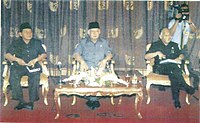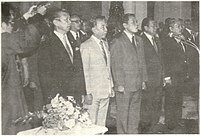Harmoko
Harmoko | |
|---|---|
 Official portrait, 1992 | |
| 9th Speaker of the People's Consultative Assembly | |
| In office 1 October 1997 – 30 September 1999 | |
| President | |
| Preceded by | Wahono |
| Succeeded by | Amien Rais |
| 12th Speaker of the People's Representative Council | |
| In office 1 October 1997 – 30 September 1999 | |
| President |
|
| Preceded by | Wahono |
| Succeeded by | Akbar Tandjung |
| 6th General Chairman of Golkar | |
| In office 24 October 1993 – 11 July 1998 | |
| Preceded by | Wahono |
| Succeeded by | Akbar Tandjung |
| 22nd Minister of Information | |
| In office 19 March 1983 – 16 March 1997 | |
| President | Suharto |
| Preceded by | Ali Murtopo |
| Succeeded by | R. Hartono |
| Personal details | |
| Born | 7 February 1939 Patianrowo, Nganjuk, East Java, Dutch East Indies |
| Died | 4 July 2021 (aged 82) Gatot Soebroto Hospital, Jakarta, Indonesia |
| Cause of death | COVID-19 |
| Resting place | Kalibata Heroes Cemetery |
| Political party | Independent |
| Other political affiliations | |
| Spouse |
Sri Romadhiyati
(m. 1972; died 2021) |
| Occupation | |
Harmoko
Born from humble origins in East Java, on 7 February 1939, Harmoko graduated from journalistic school, and became a journalist. He was active during the Guided Democracy and New Order regimes, working in a number of different newspapers, including Merdeka, Merdiko, and Harian Mimbar Kita. In 1970, he founded his own newspaper, the Pos Kota in Jakarta. In 1970, he was elected as the General Chairperson of the Indonesian Journalists Association (PWI) branch in Jakarta, and two years later, he was elected as the General Chairperson of the entire PWI.
In
Despite years of loyalty to President Suharto, following widespread student demonstrations calling for a change of government, Harmoko caused great surprise at a press conference by asking the president to step down within five days. Likely due to the fact that he may have been upset by his dismissal as information minister, his dismissal as a possible vice presidential candidate, and his house being burned down by protesters. Suharto saw Harmoko's request as a betrayal, while Tadjus Sobirin, the former chairman of Golkar's Jakarta branch called Harmoko "Brutus" during a leadership meeting of the party, a reference to Roman senator Marcus Junius Brutus, who assassinated his great-uncle Julius Caesar. Harmoko died on 4 July 2021 at the Gatot Soebroto Army Hospital due to COVID-19, and was buried the following day at Kalibata Heroes Cemetery.
Early life and education
Harmoko was born in Patianrowo Village,
Journalism career

After graduating from Journalistic school in Jakarta, he worked as a journalist and cartoonist at the Harian Merdeka (Merdeka Daily) newspaper, until 1962, when he left to work for the Berita Merdeka (Merdeka Magazine). In 1964, he left Berita Merdeka, and went to work at the Harian Angkatan Bersenjata (Armed Forces Daily). He continued his journalistic career at the API Daily in 1965, before serving as the editor-in-chief of the Javanese-language magazine, Merdiko. In the following year, he became the head of the Harian Mimbar Kita newspaper.[6]
In 1970, he, together with some friends, founded his own newspaper, the
His paper's success made him a figure within the Indonesian press. In 1970, he was elected as the General Chairperson of the Indonesian Journalists Association (PWI) branch in Jakarta. He served as the chair of the branch from 1970 until 1972, when he was elected as General Chairperson of the Central PWI in 1973. He served as General Chairperson of the PWI from 1973 until 1983, becoming the longest serving chairperson of the PWI.[7]
Political career
Cabinet minister
In
Following a term as deputy chairman, Harmoko was chairman of the
Suharto saw Harmoko's request as a betrayal, and when Harmoko attempted to visit Suharto on his deathbed in 2008, he was refused.[19] Tadjus Sobirin, Golkar's Jakarta chairman in 1998, called Harmoko "Brutus" during a leadership meeting of the party.[20]
-
Harmoko (left) sitting alongside President Suharto and Vice President B. J. Habibie.
-
Harmoko (fourth from left) being sworn in as a functionary of the General Elections Institution.
Death
Harmoko died on 4 July 2021 at the Gatot Soebroto Army Hospital due to COVID-19,[21][22] and was buried the following day at Kalibata Heroes Cemetery.[23] He had previously suffered from progressive supranuclear palsy since 2013.[24][25]
Honors
National honors
 Star of Mahaputera, 2nd Class (Indonesian: Bintang Mahaputera Adipradana)
Star of Mahaputera, 2nd Class (Indonesian: Bintang Mahaputera Adipradana) Star of the Republic of Indonesia Main (Indonesian: Bintang Republik Indonesia Utama)
Star of the Republic of Indonesia Main (Indonesian: Bintang Republik Indonesia Utama)
Foreign honors
 Honorary Commander of the Order of Loyalty to the Crown of Malaysia (P.S.M.)
Honorary Commander of the Order of Loyalty to the Crown of Malaysia (P.S.M.)
References
Citations
- ^ "Putra Harmoko: Nama Ayah Saya Bukan Singkatan dari Harun Mohamad Kohar". 14 April 2022.
- ^ Rahmah, Suwirta & Kamsori 2016, p. 206.
- ^ UIN Sunan Ampel 2016, p. 12.
- ^ UIN Sunan Ampel 2016, p. 13.
- ^ Secretariat General of the DPR 1999, p. 147.
- ^ Permana, Rakhmad Hidayatulloh (4 July 2021). "Mengenang Sosok Harmoko: Wartawan, Menteri Penerangan, Ketua Dewan" [Remembering Harmoko: Journalist, Minister of Information, Chairman of the Council]. news.detik.com (Website) (in Indonesian). Detik News. Retrieved 12 November 2021.
- ^ a b Gayatri 2009, p. 167.
- ^ Secretariat General of the DPR 1999, p. 141.
- ^ Secretariat General of the DPR 1999, p. 149.
- ^ a b Gayatri 2009, p. 168.
- ^ Matanasi, Petrik (6 July 2021). "Kisah Hidup Harmoko, dari Wartawan Jadi "Buzzer" daripada Soeharto" [The Life Story of Harmoko, from a Journalist to a "Buzzer" than Suharto]. tirto.id (Website) (in Indonesian). Tirto. Retrieved 12 November 2021.
- ^ The Editors 1993, p. 170.
- ^ Salim 2015.
- ^ Rogers 2014.
- ^ Schwarz 1999, pp. 418, 478.
- ^ Secretariat General of the DPR 1999, pp. 143–151.
- ^ Friend 2003, p. 341.
- ^ Schwarz 1999, pp. 620, 845.
- ^ "Akhirnya Ungkap Bukti Rahasia". detiknews (in Indonesian). 21 May 2008. Retrieved 24 January 2021.
- ISBN 978-979-99100-0-4.
- ^ detikcom, Tim. "Harmoko, Menteri Penerangan Era Soeharto Meninggal Dunia". detiknews (in Indonesian). Retrieved 6 July 2021.
- ^ "Sang Putra Akui Hasil Tes PCR Terakhir Harmoko Positif Covid-19". Tribunnews.com (in Indonesian). Retrieved 6 July 2021.
- ^ "Harmoko Akan Dimakamkan di Taman Makam Pahlawan Kalibata". KOMPAS.com (in Indonesian). 5 July 2021. Retrieved 5 July 2021.
- ^ Fadhila, Annisa Rizky. "Cerita Keluarga soal Harmoko Terpapar COVID-19 dan Riwayat Penyakitnya". detiknews (in Indonesian). Retrieved 8 November 2021.
- ^ Okezone (5 July 2021). "Cerita si Bungsu soal Harmoko Menderita Penyakit Langka sejak 2013 : Okezone Nasional". nasional.okezone.com/ (in Indonesian). Retrieved 8 November 2021.
- ^ a b UIN Sunan Ampel 2016, p. 22.
Bibliography
- "The Sixth Development Cabinet Announced March 17, 1993" (PDF). Indonesia. 55 (55): 167–176. April 1993. JSTOR 3351095. Retrieved 16 May 2020.
- ISBN 0-674-01137-6.
- Rogers, Cory (26 June 2014), "Twenty years after 'Tempo' banning reflection", The Jakarta Post, retrieved 18 May 2020
- UIN Sunan Ampel (2016). Harmoko pendiri pondok modern Al Barokah Nganjuk tahun 1992-1994 M [Harmoko, founder of the modern cottage Al Barokah Nganjuk in 1992-1994 AD] (PDF) (undergraduate) (in Indonesian). UIN Sunan Ampel. Retrieved 12 November 2021.
- Gayatri, Sri Indera (2009). Sejarah pemikiran Indonesia: (lanjutan) 1967-1998. III [History of Indonesian thought: (continued) 1967-1998. III] (PDF) (Book) (in Indonesian). Ministry of Education and Culture. pp. 166–172. Retrieved 12 November 2021.
- Secretariat General of the DPR (1999), Profil Ketua-ketua DPR RI sejak tahun 1945 s/d Agustus 1999 [Profiles of the Speakers of the People's Representative Council of the Republic of Indonesia from 1945 to August 1999] (PDF) (in Indonesian), Jakarta: Secretariat General of the DPR, archived from the original (PDF) on 12 November 2021, retrieved 16 May 2020
- Rahmah, Gina Siti; Suwirta; Kamsori, Moch Eryk (2016). "Kiprah Sudharmono dalam Sejarah Golongan Karya (1983-1988)". Factum: Jurnal Sejarah Dan Pendidikan Sejarah (in Indonesian). 5 (2): 201–219. Retrieved 12 November 2021.
- Salim, Zaid (12 September 2015), "The abuse of verbal culture", The Jakarta Post, retrieved 17 May 2020
- Schwarz, Adam (1999). A Nation in Waiting: Indonesia's Search for Stability (2nd ed.). Allen & Unwin. ISBN 9781760636913.


